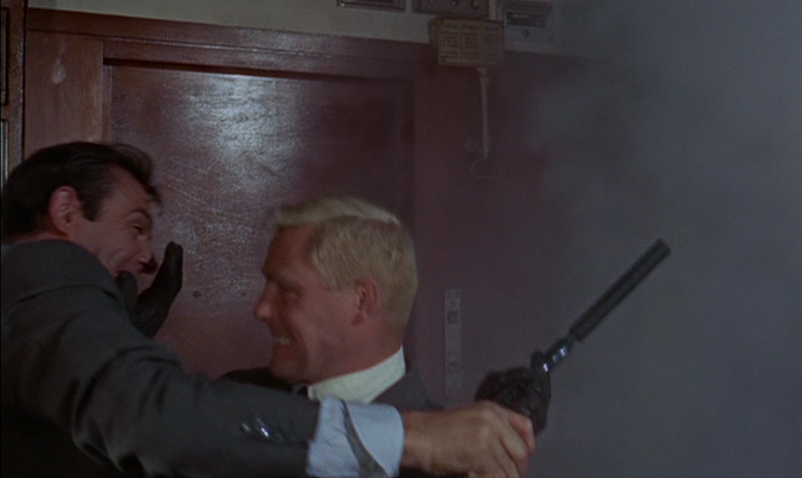Jake’s Take: One Image from From Russia with Love (Terence Young, 1963)
An image from the Orient Express fight scene in the second James Bond film leads to a brief appreciation for quick, realistic screen fights.
“My orders are to kill you and deliver the Lektor. How I do it is my business. It’ll be slow and painful.”
When I look at the fight scene on the Orient Express between Bond and Red Grant (played with the utmost ruthlessness by Robert Shaw), I can’t help but think it holds up as one of the best fights in screen history. Additionally, it’s Bond’s first fight with the first real henchman of the series.
The choreography isn’t perhaps as obvious as many more modern action scenes (though the scene reportedly took several weeks to stage). The fight occurs rapidly and—as you can see from the frame above—is downright nasty, as many more realistic fight scenes are. The cutting that balances spatial clarity and visceral impact, the close quarters staging inside the train cabin, Grant’s threatening dialogue preceding the fight—these all combine to generate tension and excitement almost unequaled in the entirety of the series’ hand-to-hand combat scenes. And when Grant pulls the garrote from his watch—we just know it’s coming—the scene “ups the ante” on this excitement.
Aside from the outstanding performative aspects of the scene—Connery and Shaw were no slouches in the rough-and-tumble department—the key to the fight is the relentless pace. Clocking in at a little under 2 minutes, the scene is more knockdown than drag-out. There is no pause for dialogue, no stopping for a breath, and why would there be? These are two men trying to kill each other, and they do so with the force of the train they are aboard. Look to GoldenEye for another example of this quick, raw combat, specifically the fight between Bond and former 00-turned villain Alec Trevelyan (Sean Bean) inside one of the control rooms of the satellite dish. With more stylization than the scene in FRWL, it is even quicker and just as violent. Regarding action scenes, check out this article by my friend and fellow Bond aficionado Colin Burnett, in which he analyzes a fight scene from Tomorrow Never Dies and talks also about the importance of sound in conveying narrative information. His thoughts mirror my own, and I would posit that his some of his comments about sound could be broadened to many of the fight scenes in the series, especially some of the later films.
The fight with Grant points to a larger notion—namely that when major villains are former or current agents, or when they pose a physical threat to Bond, they play as more compelling villains. For all of Rosa Klebb’s, Kronsteen’s and Blofeld’s scheming, Red Grant is arguably granted more script agency and, thus, becomes at least a hybrid of major villain and henchman. The real showdown is with him, after all, and he is the one in the field. He may get his marching orders from Klebb, but she is dispensed with in the same kind of postscript as many later henchmen are. Think also of Trevelyan and certainly Silva (Javier Bardem) in Skyfall, who function as physical and psychological mirrors of Bond. Blofeld is especially more interesting when played by Telly Savalas in OHMSS, not only because he gives a more genuinely threatening and grander performance than Donald Pleasance or Charles Gray, but because he is the only incarnation of Blofeld that truly poses a physical threat to Bond.
Just as the Bond/Grant fight scene holds up as one of the best in the series, so too does the film itself. Without a doubt, From Russia with Love is the best film in the Connery cycle. While SPECTRE is pulling the strings here as well, it’s also the only 1960s entry has a “Cold War feel,” with the plot revolving around disinformation and the prize of a Russian decoding machine. The stakes in the film may not be as high as its predecessor, but the intrigue is certainly greater. The film ever so slightly turns up the deadpan humor, but retains an undeniable edge and a vitality derived from a lead actor who is growing more confident in his role, the inescapable allure of Daniela Bianchi as Tatiana Romanova (assuming the notion you would want to escape it, which is preposterous), and the heartening conviviality of Pedro Armendariz as Kerim Bey, one of the series’ very best allies. Plus, we have the score of John Barry, the man who realized that one missing element for a successful rendition of “The James Bond Theme:” bongos.
Starting here, at the end of each post, I will be ranking the films. For those of you keeping score at home, out of 23 films:
5. From Russia with Love
10. Dr. No
